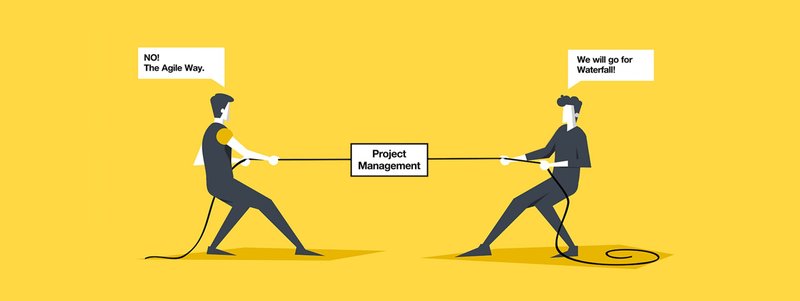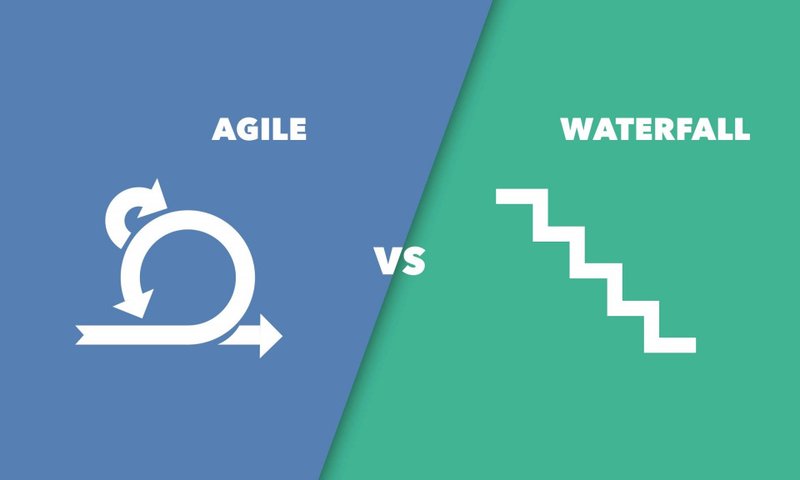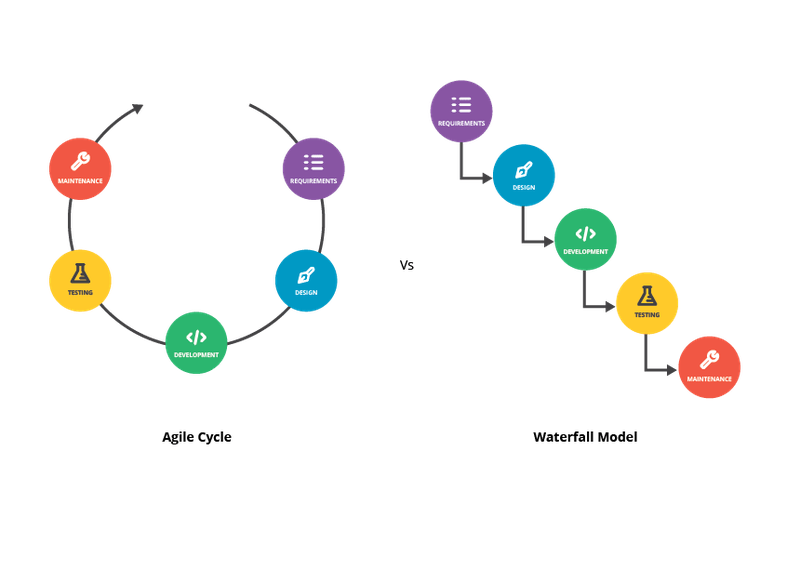Agile or Waterfall: Which Methodology Wins for Your Project?
Hello there! So, you're looking for the best software development approach, aren't you? Let me tell you, my buddy, finding the proper one is no easy task. It's like trying to choose the perfect flavor of ice cream when you're standing in front of a giant freezer with a million alternatives. Believe me, I've been there.

But don't worry! I'm here to help you navigate this maze of methods and throw some light on two major players: Agile and Waterfall. For good cause, these approaches have become the talk of the town. They each have their own distinct vibe, and recognizing them can assist you in making educated judgments for your projects.
Consider Agile to be that daring friend that is always ready for unplanned road trips, accepting change, and partnering with others along the way. Waterfall, on the other hand, is more like your organized friend who methodically prepares everything, adheres to a rigid deadline, and ensures that every step is completed in the correct order.
Here's the thing. The significance of selecting the correct software development method/approach cannot be overstated. It's similar to selecting the best tool for the job. You wouldn't use a hammer to repair a leaking tap, would you? Similarly, employing the incorrect methodology might cause extra difficulties and delays

In this article, we'll look at Agile and Waterfall in greater detail. I'll explain it to you in layman's words, with no technical jargon. We'll look at their advantages and disadvantages, as well as how they can affect the success of your project. It's all about finding the sweet spot that corresponds to your objectives and project requirements.
So, take a cup of your favorite beverage, sit back, and join me on this trip. By the end of this course, you'll have a better grasp of Agile and Waterfall approaches, and you'll be well-prepared to make the wise option for your next software development journey. Let's get started, shall we?

Agile Methodology: Embracing Flexibility and Collaboration
A. Definition and principles of Agile methodology
Let's get started in the wonderful world of Agile methodology! So, exactly what is Agile? Consider it a mindset, a method of conducting software development that emphasizes adaptability, cooperation, and continual improvement. Agile is like having a superpower that allows teams to easily navigate the ever-changing technological landscape.
The Agile Manifesto, a set of values and guiding principles is the foundation of Agile concepts. It prioritizes people and interactions over processes and technologies, functional software over exhaustive documentation, customer collaboration over contract negotiation, and adapting to change over sticking to a plan.
Agile, in a nutshell, is about embracing flexibility and empowering teams to respond rapidly to feedback and changing requirements. It's like having a supercharged sports car that can take sharp turns on a dime, allowing you to adapt and adjust course as needed.
B. Agile's iterative and incremental approach
This is where Agile truly shines. Rather than waiting months or even years for the final product, Agile divides the development process into bite-sized parts known as iterations or sprints. Each iteration is focused on delivering a functioning piece of software that builds on prior iterations.
Assume you're constructing a house. You wouldn't wait until the entire house was built to make changes or see any progress with Agile. Instead, you'd create the foundation first, then progressively add walls, rooms, and other components. This iterative process ensures that a working product is available at each stage, allowing for ongoing input and improvement.
C. Advantages of Agile in fostering innovation
Agile's capacity to stimulate innovation is one of its primary benefits. Agile enables team members to exchange ideas, experiment, and iterate quickly by emphasizing collaboration. It's similar to having a brainstorming session in which everyone's creative juices flow, resulting in breakthrough ideas and solutions.
Assume you're working on a new mobile app. You can use Agile to release an early version with rudimentary functionality and solicit user input. You can immediately identify what works and what needs to be improved based on that feedback. This iterative method enables speedy innovation while also ensuring that you are creating a product that actually satisfies the demands of your users.
D. Case studies highlighting successful Agile implementations
Let's look at some real-world case studies to properly understand the power of Agile. Take, for example, Spotify. They adopted Agile approaches in order to change the way they develop and release software. Spotify was able to consistently release new features and improve its music streaming product by utilizing cross-functional teams and an iterative strategy.
Another noteworthy example is the Agile transformation at the UK's Government Digital Service (GDS) used Agile practices across many government departments, resulting in speedier delivery of citizen-centric digital services and cost savings.
These case studies highlight the real-world benefits of Agile. It is not just a theoretical concept, but a tried-and-true technique that has transformed software development in a variety of industries.
That's all there is to it! We've looked at the definition and principles of Agile, its iterative methodology, the benefits it provides in promoting innovation, and some fascinating case examples. Agile software development is all about adaptation, cooperation, and always pushing the boundaries of what's possible. Stay tuned as we continue our exploration of the Waterfall approach!
Waterfall Methodology: Sequential Planning and Execution
A. Definition and characteristics of the Waterfall methodology
Let's now shift gears and look at the Waterfall process. Consider a road trip with a precisely planned path from beginning to end. That is the essence of the Waterfall methodology—an organized, step-by-step approach to software development.
Each ingredient is added one at a time in the Waterfall kitchen, and you can't move on to the next stage until the previous one is finished. Similarly, development proceeds in a linear fashion with the Waterfall process, moving from one step to the next—requirements collection, design, implementation, testing, and deployment.
B. The structured and linear nature of the Waterfall
In contrast to the flexibility of Agile, the Waterfall methodology is more regimented and sequential. It's similar to building a house, where you start with the foundation and work your way up to the walls, plumbing, and electrical work. Before moving on to the next stage, each stage is painstakingly planned and implemented.
Consider it like following a recipe. You meticulously adhere to each instruction, step by step, without deviating. While this method assures that the process is well-documented and predictable, it also allows little space for tweaks or alterations along the route.
C. Advantages and limitations of the Waterfall approach
The Waterfall system has its own set of benefits and drawbacks. On the plus side, it establishes clear milestones and deliverables. This makes tracking progress and managing expectations easier. Furthermore, the linear form of Waterfall might be advantageous for projects with consistent and well-defined requirements.
However, Waterfall's rigidity might be a disadvantage in dynamic contexts. If adjustments are required later in the development process, going back and modifying earlier stages can be difficult and costly. It's like discovering you need more ingredients for a recipe after the dish has already been baked—it's not an easy repair.
D. Real-world examples showcasing Waterfall methodology effectiveness
Waterfall has been widely employed in a variety of industries, particularly in projects with generally stable and predictable requirements. Waterfall, for example, is frequently used in the construction industry to assure the exact planning and execution of building projects.
Another famous example of the Waterfall methodology's efficiency is NASA's Apollo program. Each mission followed a set of steps, from developing the spacecraft to testing it and finally sending it into orbit. The Waterfall method aided NASA's astounding accomplishment in reaching the moon.
These examples show how the Waterfall methodology might be useful in some situations. It all comes down to selecting the best technique depending on the characteristics and requirements of the project.
So far, we've looked at Agile's flexibility and collaboration, and now we'll look at the Waterfall methodology's structure. Both tactics have advantages, and we'll discuss which one is ideal for you in the following section. Keep an eye out!
Decoding the Best Methodology for Your Project
A. Factors to consider when selecting a methodology
When it comes to selecting the best software development approach for your project, there are various aspects to consider. The project's complexity is an important consideration. Is it a small-scale project with well-defined requirements, or a huge and dynamic project with changing requirements? Understanding the scope and nature of the project can help guide your decision-making process.
Another critical factor to consider is the level of collaboration and communication required. Is your staff small and co-located, allowing for face-to-face contact, or is it scattered across multiple regions and time zones? The level of participation required can influence your methodology selection.
B. Evaluating project requirements, team dynamics, and stakeholder involvement
To determine the optimal technique for your project, you must first assess the project needs, team dynamics, and stakeholder engagement. For example, if your project necessitates frequent changes and feedback, Agile's adaptability may be ideal. The Waterfall approach, on the other hand, maybe more appropriate if your project has well-defined and steady needs.
Consider the level of stakeholder participation as well. Are your stakeholders actively involved in the development process, or do they want to remain hands-off? Aligning the technique with the expectations of stakeholders might result in better project outcomes.
C. Choosing between Agile and Waterfall based on specific project characteristics
You may now make an informed choice between Agile and Waterfall based on the project characteristics we've examined. Remember that there is no one-size-fits-all solution. Agile is best suited to tasks that require flexibility, adaptability, and tight collaboration. Waterfall, on the other hand, is better suited for projects with consistent needs and more sequential execution.
Consider the following analogy as an example. Assume you're organizing a wedding. The Waterfall technique may work effectively if you have a defined guest list, venue, and timeline. However, if you foresee changes in the guest list, venue availability, or other variables, Agile's iterative nature makes alterations easier.
Conclusion:
A. Recap of Agile and Waterfall methodologies
In conclusion, Agile and Waterfall are two separate software development approaches. The waterfall is a sequential strategy, whereas Agile is flexible and collaborative. Understanding their qualities allows us to make more educated choices.
B. Partnering with Decodermind for your IT development projects
Decodermind provides a wide range of services, from dynamic mobile app development to personalized corporate solutions and cutting-edge web development. Catering to a diverse clientele across various niches and sizes, we have extended our services to clients in the USA, UK, and Europe.
Decodermind is ready to be your trusted partner on this technological journey, whether you are a startup looking for a disruptive app, an established corporation aiming for digital transformation, or a firm in need of bespoke solutions. Our diverse approach, founded on creativity and technical competence, is adapted to the specific needs of your digital ambitions.
We welcome your ideas, questions, and participation. Your ideas inspire our never-ending quest for innovation. Share your thoughts, inquire about our services, or find us on social media. The future of digital innovation in the United Kingdom is not just a story we tell; it is a narrative we co-create. Join us in shaping the next chapter in the technological growth of the United Kingdom. Explore, interact, and embark on a digital transformation journey with Decodermind.

 Hamid Salman
Hamid Salman